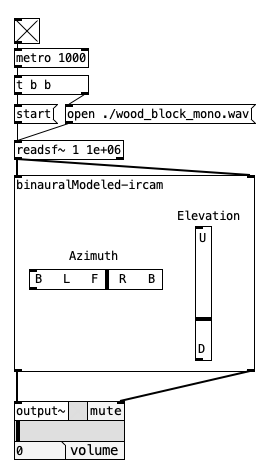An efficient binaural spatializer
The "binauralModeled-ircam" object is a pure-vanilla implementation of the binaural model created at IRCAM.. An example of its capabilities can be found at this page.
The object is found at my repository: https://github.com/andresbrocco/binauralModeled-pd
Main concept
Basically, it applies ITD and approximates the HRTF to a series of biquad filters, whose coefficients are avaliable here.
Sample Rate limitation: those coefficients work for audio at 44100Hz only!
Space interpolation
There is no interpolation in space (between datapoints): the chosen set of coefficients for the HRTF is the closest datapoint to the given azimuth and elevation (by euclidean distance).
Time interpolation
There is interpolation in time (so that a moving source sound smooth): two binauralModels run concurrently, and the transition is made by alternating which one to use (previous/current). That transition occurs in 20ms, whenever a new location is received.
Interface
You can control the Azimuth and Elevation through the interface, or pass them as argument to the first inlet.

Performace
Obs.: If the Azimuth and elevation does not match exactly the coordinates of a point in the dataset of HRTFs, the object will perform a search by distance, which is not optimal. Therefore, if this object is embedded in a higher level application and you are concerned about performance, you should implement a k-d tree search in order to find the exact datapoint before passing it to the "binauralModeled-ircam" object.
Ah, maybe this statement is obvious, but: it only works with headphones!



 That's short for [expr(1-$f1)]: the exclamation point reverses the order of the inlets when preceding basic math operators + - * /
That's short for [expr(1-$f1)]: the exclamation point reverses the order of the inlets when preceding basic math operators + - * /


